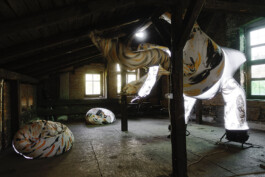

STRESS(link)
curated by Goschka Gawlik, in collaboration with Stefan Reiterer
Oct 6 – 30, 2022, Elementarz mieszkańców miast, Kraków (map)
(...) In the ‚looped’ attic space of the Krakow art institution Elementarz dla Mieszkańców Miast (Primer for City Dwellers), artists Stefan Reiterer in collaboration with Georg Petermichl (*1980) build a multi-part environment composed of illusionistic bodies and digital animations. Visitors, navigating a half-dark, half-lit maze of wooden beams and brick walls, roughly in the middle of the installation encounter a dancing and noisy horror-machine: a hybrid skydancer figure named Muli. Similar shaky figures – usually with monstrous shapes and overwhelming forms – usually appear in the world of advertising, where they draw consumers’ attention to selected products with their movements and behaviour. This time, however, the skydancer hybrid has been adapted by artists for their own artistic aims and purposes. Namely, Muli represents the connections between the human and the non-human. The inflatable sculpture, set on fan jets, is made of striped, reflective material and changes according to the time of day: in daylight the brindle pattern, characteristic of Reiterer’s textile works, can be seen to disappear in the dark, while at night some other parts of the figurative sculpture light up. Muli’s anthropomorphic silhouette, her organic movements and her artificial shell contrast with each other – the artists’ aim, however, was not a simple play of opposites. (...)
part of the exhibition text by Goschka Gawlik


STRESS(link)
curated by Goschka Gawlik, in collaboration with Stefan Reiterer
Oct 6 – 30, 2022, Elementarz mieszkańców miast, Kraków (map)
(...) In the ‚looped’ attic space of the Krakow art institution Elementarz dla Mieszkańców Miast (Primer for City Dwellers), artists Stefan Reiterer in collaboration with Georg Petermichl (*1980) build a multi-part environment composed of illusionistic bodies and digital animations. Visitors, navigating a half-dark, half-lit maze of wooden beams and brick walls, roughly in the middle of the installation encounter a dancing and noisy horror-machine: a hybrid skydancer figure named Muli. Similar shaky figures – usually with monstrous shapes and overwhelming forms – usually appear in the world of advertising, where they draw consumers’ attention to selected products with their movements and behaviour. This time, however, the skydancer hybrid has been adapted by artists for their own artistic aims and purposes. Namely, Muli represents the connections between the human and the non-human. The inflatable sculpture, set on fan jets, is made of striped, reflective material and changes according to the time of day: in daylight the brindle pattern, characteristic of Reiterer’s textile works, can be seen to disappear in the dark, while at night some other parts of the figurative sculpture light up. Muli’s anthropomorphic silhouette, her organic movements and her artificial shell contrast with each other – the artists’ aim, however, was not a simple play of opposites. (...)
part of the exhibition text by Goschka Gawlik